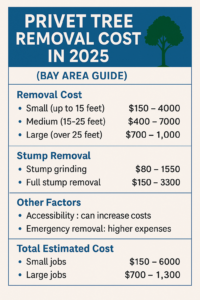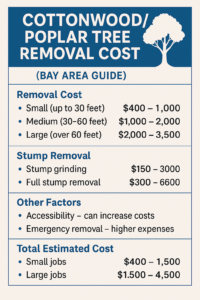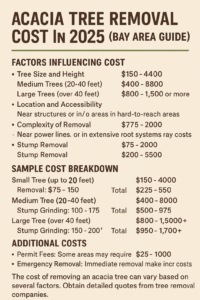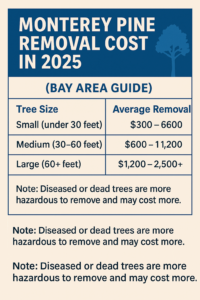Do you require emergency tree removal services? Trees are an essential part of landscaping. However, there comes a time when they can become hazardous or obstructions to an otherwise perfect view. The average cost of removing a tree in California ranges between $650 to $1300. Several factors affect the price, from tree size, to species, location, health, and accessibility.
Here is a complete guide to help you make accurate estimates on the cost of tree removal in an emergency. This blog breaks down every factor and condition you may require to consider and ways to find cost-effective solutions in emergencies. It also highlights a breakdown of costs.
Go to:
- Factors that Affect Emergency Tree Removal Costs
- Partner with Us for Emergency Tree Removal Services
Factors that Affect Emergency Tree Removal Costs

1. Tree Species
California’s versatile topography is home to many tree species prevalent in coastal, desert, and mountainous regions, from the coastal live oak to desert willow, the Californian buckeye, palm tree, western redbud, and the staple redwood. Each of these trees has characteristics that influence the removal costs.
The wood can be soft or hard, influencing the force required to cut the tree down. Tree height also influences the machinery, workforce, and tree-slicing technique. All these requirements influence pricing.
Table Showing Emergency Tree Removal Cost Per Species
| Tree Species | Type of Wood | Height | Removal Costs |
| Coastal Live Oak | Hardwood | 15ft -100ft | $275 – $6000 |
| California Buckeye | Hardwood | 36ft | $450 – $700 |
| Palm Tree | Monocots | 20ft -100ft | $150 – $1150 |
| Western Redbud | Hardwood | 10ft -20ft | $50.99 – $363.99 |
| Californian Redwood | Hardwood | 60ft – 240ft | $450 – $2000 |
| Giant Sequoias | Hardwood | 250ft -300ft | $6000 – $8000 |
2. Tree Width and Height
Tall trees require intricate strategies and specialized equipment, like cranes, to safely cut them down without affecting adjacent infrastructure and property. Arborists also work harder on tall trees with larger diameters. The thicker branches and large canopy make the removal process more complex and time-consuming. Thus, the taller and wider the tree, the higher the removal cost.
Arborists can charge as low as $5 per foot in California when removing a tree. The cost varies depending on tree species characteristics, from the type of wood to tree diameter and canopy complexity. For instance, the Californian Redwood has height but cannot compare to giant sequoias, which can have diameters as wide as 30 feet near the ground. The price of removing a giant sequoia can be as high as $20 per foot because of the tree’s width.
Arborists consider trees under 30 feet small, costing about $8 per foot to remove. Trees 60 feet and over fall under the large category and may cost upwards of $18 per foot.
| Tree Height | Tree Width | Removal Cost/feet |
| 60 ft and above | Average width | $18 |
| 30ft – 60ft | Average width | $12-$16 |
| Below 30ft | Average width | $8 |
3. Wider Canopy
A tree with more branches and foliage requires more time and labor to trim and prune before cutting down the stem. Arborists also use specialized equipment to contain the debris and reduce property damage risk and accidents on site. The weight of the canopy also becomes a major concern if there are adjacent property, public infrastructure, or utility lines.
Therefore, the tree canopy adds to the cost of tree removal. One way to reduce this cost is by pruning the branches regularly to reduce the weight of the compromised tree before the emergency removal. Ensure to work under the guidance of a certified arborist to prevent accidents and property damage.
4. Tree Accessibility

Another determining factor for emergency tree removal cost is the ease of tree access. Trees in proximity to underground and above-ground utility lines, property, obstacles, or faces are challenging to remove. Tree removers circumvent adjacent infrastructure to safely fall the tree without posing any risks.
In an emergency, these factors add weight to the work complexity. For instance, space may limit machinery use as heavy cranes and wood chippers may not access the area. Spatial constraints may also limit the number of arborists working to remove the tree, leading to longer working hours. Thus, the easier it is to access the tree, the more affordable the tree removal rate in an emergency.
5. Tree Health
The condition of the tree also impacts removal costs. Californian trees are susceptible to fungal and bacterial diseases and pest infestations, which require emergency removal by professional arborists with licenses to operate in the state. Top on the list of fungal infections is the sudden oak death typical in oak trees. The disease causes branches or stems to die, manifesting as trees leaning awkwardly, posing a threat to human life, nearby properties, or utilities.

Additionally, pests like bark beetles and bores weaken trees, declining their health and structural integrity. A compromised tree is hazardous to the surrounding environment. It may spread the disease to adjacent plantations, fall on unsuspecting people, or damage property.
Arborists contain the fungal, bacterial, or pest infestation, preventing it from spreading into the region. Then, set up strategies to remove the compromised tree safely. The intricacies involved in felling the tree make the emergency service costly.
The process entails an in-depth inspection to diagnose the tree’s condition and develop removal strategies. Tree removers also focus on potential hazards during removal to prevent infection from spreading, property damage, and accidents. They also factor in disposal solutions to curb the spread of the infestation.
6. Service Cost Per Hour
Most arborists in California charge hourly rates for their tree removal services, including emergency services. The average rate for removing trees ranges between $30 and $50 per hour. Price variations depend on the number of workers required to complete the emergency service. The more complex the tree removal process and other services like pruning and trimming, the higher the cost.
For instance, in a limited space where machinery and workforce cannot co-function, arborists may require more hours to take down the compromised tree. Consequently, the labor-intensive procedure will be more costly.
7. Fallen Tree Removal
Once the tree is down, you may require supplementary services to clear your yard. Tree-removing companies provide wood-chipping services and eco-friendly disposal for health-compromised trees. Wood chipping will cost about $100 to $600, depending on the tree’s length, width, and canopy size.
Alternatively, you can use the wood chips as mulch in your yard or save the logs for your outdoor fireplace or barbeque to reduce disposal costs. Remember, this option is only available for a pest or disease-free tree. Storing the wood for infected trees can spread the disease to surrounding trees.
8. Tree Removal Permits
Aside from removing the tree, California requires permits and permissions from your local government to cut down heritage trees and protected species in residential, commercial, and municipal properties. Permit costs vary on a case-by-case basis, and the permission to cut a tree may also depend on tree size and visual aesthetics.
Partner with Us for Emergency Tree Removal Services
At Fire Fighter Tree Services, we provide affordable emergency tree removal solutions in California. Work with professional arborists for quick, effective, and reliable tree removal services. Leverage our local knowledge of tree species, conditions, felling techniques, and government requirements for seamless service delivery. Call us today and prevent a hazardous situation in your compound.






